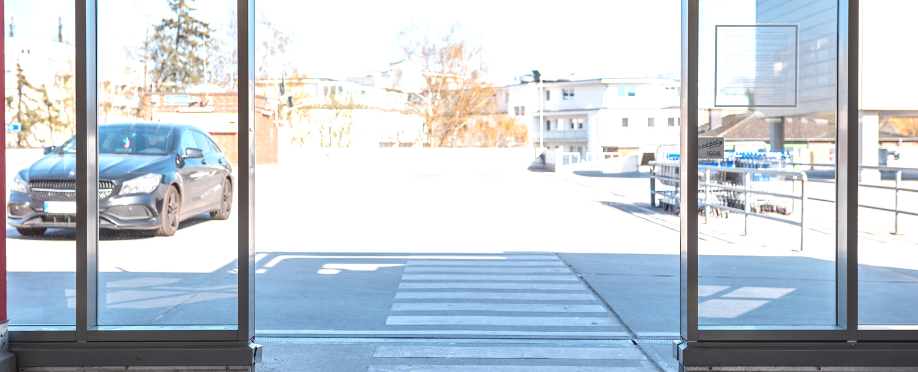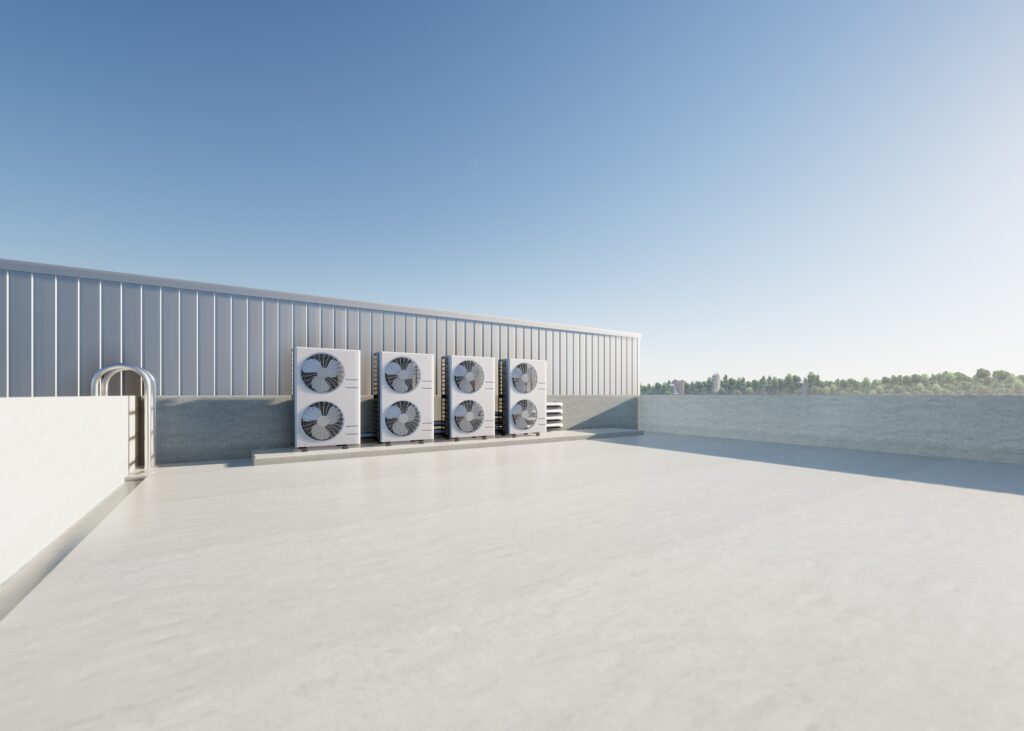
The building envelope, often referred to as a structure’s “skin,” is one of the most critical aspects of any building. It acts as a barrier, protecting the interior environment from external elements, and plays a major role in energy efficiency and overall comfort.
In the case of a grocery store facility, the building envelope is especially vital due to the unique challenges of the food retail industry — namely, trying to keep huge amounts of food product safe and fresh for shoppers. In our guide, we’ll dive into the various intricacies of managing the building envelope of grocery stores, supermarkets, and other retail facilities that use commercial refrigeration.
What is the Building Envelope?
What is the envelope of a building? Before we delve into the management strategies, let’s take a look at what the building envelope comprises.
Sometimes referred to as a “thermal envelope,” the building envelope is physical components separating the interior environment from the exterior. It typically includes the roof, walls, windows, doors, and foundation and is responsible for creating the indoor environment of a facility.
The five main components of a grocery store building envelope are:
- Exterior walls: These provide structural support and insulation, regulating internal temperature and protecting facilities against the elements.
- Roofing system: The roof is a critical element for weather protection, insulation, and overall energy efficiency.
- Windows and doors: Windows and doors should be equipped with energy-efficient materials in order to minimize heat transfer, control natural light, and maintain an airtight seal from the outside environment.
- Insulation: Placed in walls, roof spaces, and floors, insulation reduces heat transfer and enhances energy efficiency.
- HVAC systems: Heating, ventilation, and air conditioning systems regulate the temperature within a facility, influencing the building envelope’s performance.
A grocery store building envelope typically does not include the following:
- Interior fixtures
- Shelving
- Refrigeration units
- Display cases
- Other internal components
Why does the building envelope matter?
For a grocery store, this barrier is vital for several reasons.
- Food safety: The building envelope helps regulate the interior temperature, ensuring that perishable goods are stored at appropriate temperatures.
- Energy efficiency: A well-managed building envelope can significantly reduce energy consumption, leading to substantial cost savings and a more sustainable environment.
- Customer experience: A well-maintained building envelope ensures a comfortable shopping environment for customers, leading to return visits.
What is the Ideal Indoor Environment for a Grocery Store?
What does an ideal indoor environment look like in a store?
A slightly positive air pressure helps prevent outdoor temperatures and external contaminants from entering. According to George Campbell, Director of Technical Services at City, this is usually about 5 psi, but this may vary.
“When a store has positive pressure,” George explains, “you’ll feel the air conditioner blowing in your face as you walk inside. The hot air shouldn’t follow you. In cold climates, likewise, the cold air shouldn’t follow customers inside.”
Temperature ranges from 32°F to 40°F for refrigerated sections and 0°F or lower for frozen sections, preserving the freshness of perishable items.
Humidity levels are usually tailored to specific sections in grocery stores, with higher humidity (around 90-95%) in the produce section to keep fruits and vegetables fresh and lower humidity in dry goods sections.
Controlling the dew point is also essential to prevent condensation on surfaces. While the dew point may not be directly controlled in a grocery store, it can be managed by ensuring the environment is well ventilated and there are no temperature differentials that could potentially cause condensation.
| Dew point vs. humidity: What’s the difference?
Humidity refers to the amount of water vapor present in the air. It’s often expressed as a percentage, indicating the relative humidity. The dew point is the temperature point at which air becomes saturated with moisture, leading to the formation of dew, or water droplets, on surfaces — most famously on refrigerator cases in food retail stores. It’s a vital indicator of humidity. When the air temperature equals the dew point, the air will have a relative humidity of 100% and is considered to be saturated. |
Challenges Unique to Grocery Store Facilities
“One of the biggest challenges for grocery retailers is managing their building envelope,” says George. Unlike other commercial buildings, grocery stores have specific operational demands:
- Grocery stores require extensive refrigeration systems to keep products fresh. If not properly managed, these systems can strain the building envelope.
- High customer foot traffic through automatic sliding doors can impact their efficiency and integrity.
- Many grocery stores have large exterior signage that may affect the envelope’s insulation and performance.
- Grocery stores, especially in certain climates, have to contend with weather exposure to various conditions, such as high winds, heavy rain, and extreme temperatures.
Effective Building Envelope Management Strategies
Given the challenges above, effective management of the building envelope is essential. Here are some strategies to ensure your grocery store facility’s envelope performs optimally:
Strong PPMS
It all starts with a strong PPM, or planned preventive maintenance program, explains George, a long-time proponent of proactive maintenance. “As long as PPMs are performed regularly and properly, you’ll prevent most building envelope or indoor environment issues you’ll run into.” He also adds that investing in technician training can go a long way in terms of preventing issues or breakdowns that can lead to building envelope issues.
Energy Efficiency Upgrades
While most grocery stores are already stepping up their energy efficiency, there may be other upgrades to consider, such as installing energy-efficient windows, updating insulation, or upgrading roofing materials.
George considers energy efficient doors, tinted windows, and proper sealing and insulation to be among the most powerful energy efficiency solutions, as they’re critical for maintaining temperature control. “They make a big difference so that the HVAC system isn’t running as hard.”
But he warns facilities managers that adding sliding glass doors to their refrigeration system can result in a loss of up to 50,000 BTU in cooling, which can impact the building envelope significantly. “While this solution is vital for saving on energy, it’s important to be aware of this differential and upscale your HVAC system accordingly in order to offset the BTU loss,” he says.
HVAC Optimization
Are you experiencing issues with your facility’s building envelope? The first place to start is typically with the HVAC system.
Steve Moss, Head of Refrigeration & HVAC at City, recommends the following steps in the case of building envelope issues:
- Check the AC unit and make sure it’s working properly, and the various components are in balance.
- Check exhaust fans and makeup air fans. These are supposed to bring in the same amount of air you’re exhausting. “Some people will turn off the supply air. You have to bring in the same amount of air. Otherwise, if you exhaust more than you bring in, you’re going to have negative air pressure.”
- Make sure the motor room or mechanical room is properly sealed. “The exhaust fans are running 24/7. If the room isn’t sealed, you’re going to start exhausting treated air, which can cause negative pressure.”
- Test the outside air dampers to make sure they’re effectively regulating fresh air intake, allowing appropriate ventilation.
- Make sure all the belts in the system are tight and running as they should be.
- Make sure the ductwork is properly sealed and insulated. “If the air isn’t going where it’s meant to go, it’s being sent somewhere else, potentially compromising the indoor environment.”
Steve also suggests making sure the A/C in the entry vestibule space is working properly. “Since there’s no product in this space, it’s easy to neglect it, but if it’s not operating as it should, it could cause building envelope issues.”
Other tips for managing the building envelope
- Invest in high-quality roofing to prevent leaks and improve energy efficiency.
- Seal all entrances and exits to maintain the building’s thermal integrity.
- Consider using air curtains or an air-conditioned entry vestibule to ensure the outside air never blows directly into the store.
- Regularly inspect and maintain exterior signage to prevent energy leaks.
- Ensure refrigeration systems are well-maintained and properly sealed to prevent energy waste as part of PPMs.
- Use heat-reflective window films with a low U-value and properly seal windows to improve energy efficiency.
- Ensure proper drainage of gutters and downspouts to prevent leaks and water damage in the building envelope.
- Create an emergency preparedness plan that includes reinforcing the building envelope and having emergency materials on hand to prevent or quickly repair damage.
Optimize Your Building Envelope with Integrated Facilities Management Solutions
Managing the building envelope of a grocery store facility is a big task that requires attention to detail and proactive maintenance. By following the strategies above, facility managers can create a comfortable shopping environment, reduce energy consumption, and extend the life of the building envelope. Not only that, they can save on energy costs while they’re at it.
At City, we offer an industry-disruptive delivery system for facilities management founded on preventive maintenance that significantly delivers energy efficiency and sustained cost savings. Learn more about our integrated facilities management services.


 2016: City US is established in North America, in partnership with Southeastern Grocers (SEG), servicing over 750 supermarkets across 7 southern states.
2016: City US is established in North America, in partnership with Southeastern Grocers (SEG), servicing over 750 supermarkets across 7 southern states. 1985: Willie and Susan Haughey establish City Refrigeration Holdings (UK) Ltd in Glasgow, UK.
1985: Willie and Susan Haughey establish City Refrigeration Holdings (UK) Ltd in Glasgow, UK. 2009: City Australia launches in Melbourne, in partnership with Coles, servicing over 700 supermarkets across the country.
2009: City Australia launches in Melbourne, in partnership with Coles, servicing over 700 supermarkets across the country. 2015: City Asia launches in Kuala Lumpur, Malaysia, in partnership with Dairy Farm, servicing over 205 supermarkets across the region.
2015: City Asia launches in Kuala Lumpur, Malaysia, in partnership with Dairy Farm, servicing over 205 supermarkets across the region.